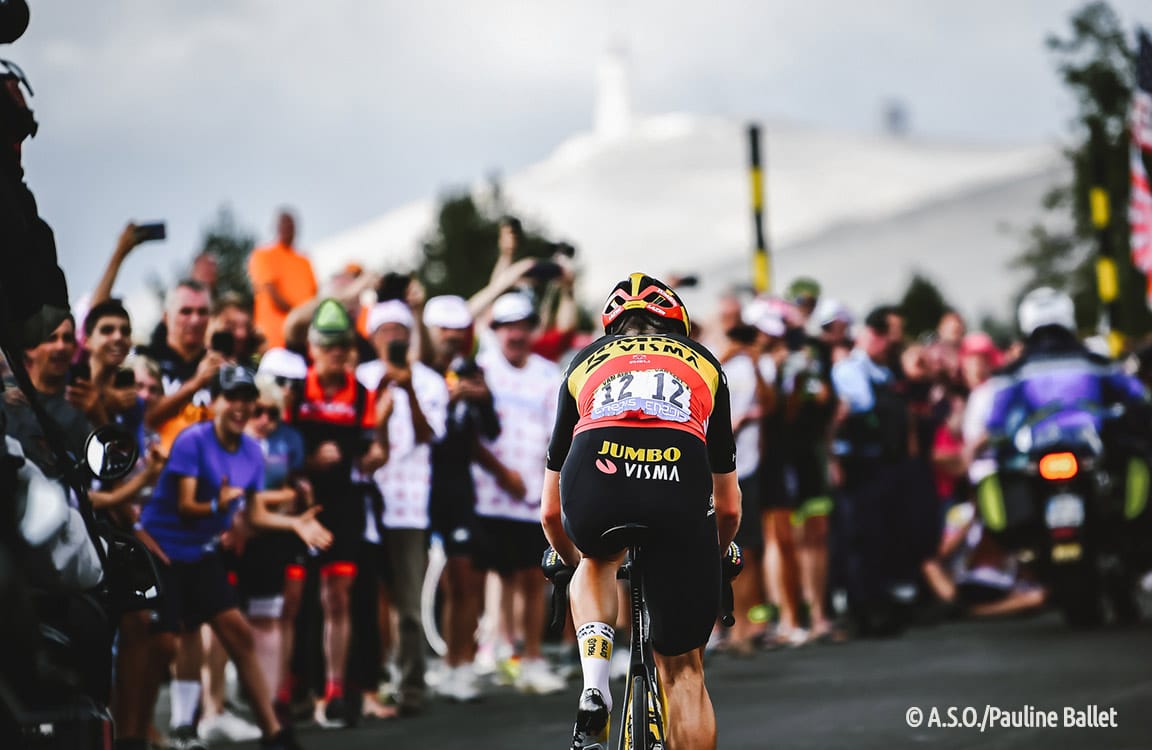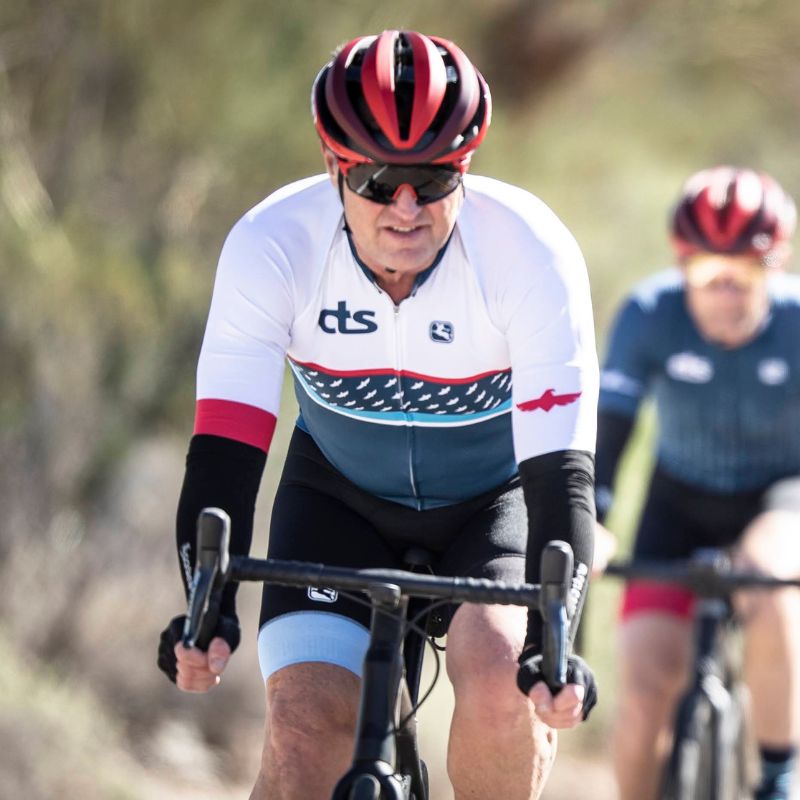
How to Pace Climbs Like Tour de France Cyclists
By Chris Carmichael,
Founder and Head Coach of CTS
Wout van Aert, the 78-kilogram (172 pound) cyclocross and Classics rider who finished second a day prior to Mark Cavendish in a bunch sprint on Stage 10, won a Tour de France stage that featured two ascents of the mythical Mont Ventoux. He didn’t have the fastest time up the mountain (that was Jonas Vingegaard, who managed to slightly crack race leader Tadej Pogacar), but he paced his efforts perfectly to stay ahead of the chasers over the summit. From the head of the pack to the grupetto, riders use different pacing strategies to win, take time, stay with the group, or just survive on climbs. You may not be climbing Mont Ventoux in your weekly group ride or your next race, but you can still use the Tour rider climbing strategies below to help you.
A heavier rider winning a mountain stage is not unheard of. Van Aert’s win evoked memories of Eros Poli (6’ 5”, 184 pounds) winning the Mont Ventoux stage of the Tour in 1994. More recently, Thor Hushovd (6’ 0”, 180 pounds) won Stage 13 of the 2011 Tour de France, which climbed the hors categorie Col d’Aubisque. And don’t forget, Miguel Indurain won the Tour de France 5 times and he was 6’ 1” and reportedly 176 pounds.
The point is, in the right circumstances and with some wise pacing choices, riders of any size can win in the mountains. So, stop writing yourself off when it comes to hilly and mountainous events. Take Wout’s advice from his interview after winning Stage 11: “It’s just a matter of always believing and keeping motivated. If you keep trying, then one day it will work out.”
Stop writing yourself off when it comes to hilly and mountainous events!
Whether you’re trying to win, take time, stay in the group, or survive to fight another day, use the guidance below to increase the chances it will work out for you, too.
Winning
If long and steep climbs aren’t your natural habitat, winning in the mountains takes strategy, commitment, and a lot of luck. Of the aforementioned riders, Poli, Hushovd, and Van Aert all won from breakaways. If you can build up a significant margin before the climb, you can ride your best sustainable pace and hope you can reach the summit before you get caught. Poli, for instance, figured he’d lose 1 minute per kilometer on Mont Ventoux, so he thought he had a chance once he had a 25-minute over the chasers. In contrast, Van Aert only started the final ascent of the Mont Ventoux with about a 4:30 lead over the yellow jersey group, and was fortunate that Vingegaard waited until near the top to attack Pogacar.
Feel Stronger in 6 Weeks — No Matter Your Age
Climbs feel steeper? Recovery slower?
You’re not done getting faster — you just need a smarter plan.
The 6-Week Masters Power Build Coaching Program is designed for cyclists 50+ who want to boost power, recover faster, and ride stronger — all with expert 1:1 coaching.
- Personalized 6-Week Training Plan
- 1:1 Coaching + TrainingPeaks Premium
- Mobility & Strength Bonus Guides
💪 Guarantee: Stronger or free.
Start your 6-week journey for $149If you start a climb with the peloton or a large group of riders that includes lighter climbers, your best chance to win is to keep the pace fast and steady at the front. Your goals are to jettison as many riders from the front group as possible, and to keep the pace high enough to dissuade the smaller climbers from attacking. This won’t typically work on an hour-long climb but can keep the front group together on a 5- to 10-minute hill or a longer but moderate grade (5-7%).
Taking Time
Attacking to separate yourself from a group and maximize your gap before the summit is all about timing. When riders attack on climbs, the gap opens quickly and then stabilizes after a few kilometers. Ideally, you want to minimize the time you spend working really hard to just maintain your advantage. On long climbs that typically means attacking closer to the top so you can create a sizeable lead and reach the summit before or as the gap stabilizes.
Staying with the group
The more common concern is staying with the group instead of being dropped. If you’re playing defense on a climb you have to minimize the number and duration of efforts that push you over your sustainable intensity. You’re going to have to dig deep, but you don’t want to go so hard that you have to slow to a crawl to recover from the effort.
► Free Cycling Training Assessment Quiz
Take our free 2-minute quiz to discover how effective your training is and get recommendations for how you can improve.
- Start at the front and drift back: Better yet, go to the front and set the pace that works for you. In many group ride and amateur race situations, the riders behind you might be perfectly okay with your pace. If people go around you to pick up the pace, don’t immediately pull the plug. Keep climbing at a pace you can sustain and gradually drift back through the group. Ideally, you’re still in contact at the summit.
- Don’t react to every little acceleration: Jumping to close every gap is a quick way to run out of energy. The initial bluster of an acceleration doesn’t last long but takes a lot of energy. Let the small gap go and accelerate at more gradual pace to reel them back in.
- Use your bodyweight: Shift up 1-3 gears and get out of the saddle. Your cadence will stay constant or slow down, but you get to use your full bodyweight to create more force on the downstroke. Getting out of the saddle isn’t just for sprinting, attacking, or closing gaps. Here you’re not increasing your effort level; you’re just standing to use your weight to maintain speed and momentum.
Surviving
A lot of cycling fans seem to think riders in the very back group, or grupetto, get to take it easy. But with the fast average speeds being set by riders at the front, there’s nothing easy about finishing inside the time cut on mountain stages. The strategy in the grupetto is somewhat different than at the front. Here, the pace on the climbs is steady and sustainable to keep the group together, but the intensity is very high on the descents and valleys to recoup some of the time lost going uphill.
Sometimes a similar strategy works in group rides and events like gran fondos or multi-day tours like Ride the Rockies. If you bury yourself on every climb, you’ll save a few minutes but have no energy to keep a strong pace on the flats or the last third of the ride. Work on your descending skills to take advantage of the free speed and think of the miles between climbs as time to ride a steady but challenging tempo to make up time. Going faster on the descents and flats may gain you more time than you lost by notching your pace back on the climb itself.
► FREE Mini-Course: Learn How to Maximize Your Limited Training Time
Learn step-by-step how to overcome limited training time and get faster. Walk away with a personalized plan to increase your performance.
"*" indicates required fields


Comments 3
Very interesting strategy particularly about not changing too much the pace of the climb
It is also a good comment for me to establish a targeted climbing time for major climbs during my ride
On a typical Saturday ride, there are 2 or 3 such climbs
Thank you!
Lots of good stuff here, Chris. Most important of those I believe is to not write yourself off. I have been riding for a dozen years with a group and have often been in the middle or near the back on climbs. Over the last year I have dropped some weight and stayed determined to get better at climbs and recently beat one of our best climbers. It was very satisfying and motivates me to commit to climb even better! It has helped tremendously that I am in better shape now thanks to one of your coaches!
I remember reader Tadej pogacar.
Thank grateful,
Yujin landscape photography.